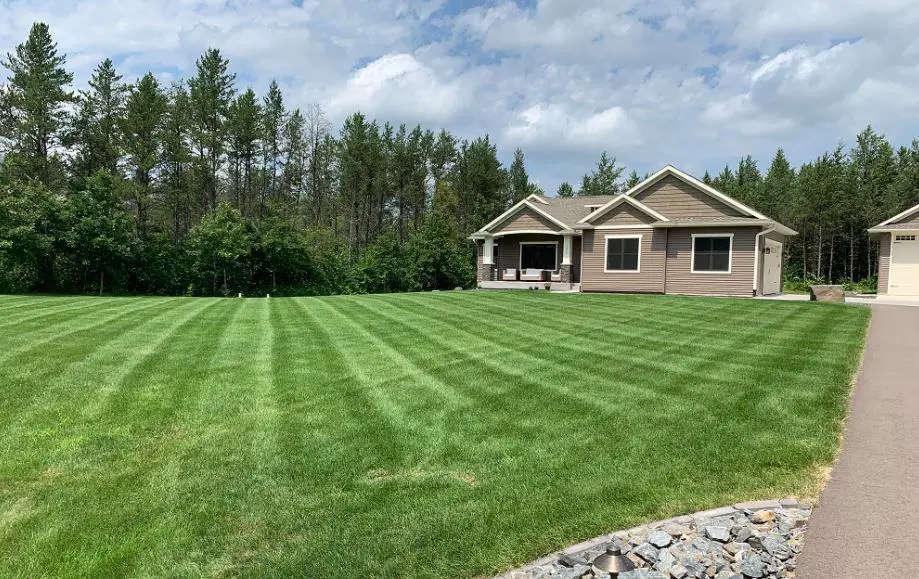Lovely lawns are not always present. A weedy, unhealthy lawn may be transformed into a beautiful carpet of green grass with timely lawn management practices, including fertilizer, aerating, and cutting. Let us look at the ideal times to plan these lawn maintenance activities for the states in the Central Midwest and the Ohio Valley.

Lawn care schedule from Wisconsin to Missouri
Well before the first blades of grass in the spring begin to turn green, lawn maintenance is necessary. Spring cleaning is the first thing to do when the snow melts off the grass. Take out the pinecones, twigs, and branches that fell throughout the winter. Pick up rubbish and rake leaves that might have blown onto the lawn.
Moreover, now is a good time to check the grass for mole damage, snow mold, and perennial weeds. Early resolution of these problems might minimize their severity. The weather and your environment will determine when to apply broadleaf herbicides, reseed barren places, and mow for the first time.
When to Start Lawn Mowing
The start dates for the Ohio Valley and southern portions of the Midwest are typically a few weeks later than those for the Upper Midwest states or Northern Illinois. When to start mowing in the spring also depends on the weather. The following recommendations are made by professionals rather than using a calendar date:
Await the grass to come from dormancy. It is okay to start mowing the grass once it grows vigorously. Cool-season grass emerges from dormancy when the soil reaches 50 degrees Fahrenheit (10 degrees Celsius), or the daily air temperature is continuously over 60 degrees Fahrenheit (16 C.).
Verify the soil’s ability to withstand mowing. Waterlogging of the ground may result from snow melt or spring rainfall. As a result, the weight of lawn machines may rut the yard and rip up the sod. Use a push mower to finish the work without harming the turf if the grass is too high.
Cut grass at the right height. During mowing, the general guideline is to remove no more than 1/3 of the length of the grass blades. When grass is cut too short, root development is hampered, which reduces the lawn’s ability to withstand drought conditions.
Indiana North and South: When to Fertilize the Lawn
The nutrients your grass needs are provided by timely fertilizer treatments. Fall is the suggested season to fertilize the lawn if you only do it once a year. The first two weeks of September are the most important times to apply a water-soluble, fast-release fertilizer in the Central Midwest’s northern areas.
Applying a high-nitrogen grass fertilizer (20-8-8) stimulates cool-season turf to store carbohydrates for the impending winter while it recovers from summer stress. This promotes root development and speeds up the springtime regreening of the grass.
Before the ground freezes, you may apply fertilizer again for up to two weeks. Autumn is also the optimum time to remove perennial weeds. Early autumn broadleaf herbicide application promotes grass growth in bare spots left by dying weeds.
It is advised to apply fertilizer early or annually in late September to early October in southern regions of the middle Midwest and Ohio Valley. If desired, early November is the ideal time to apply a second fertilizer treatment.
Ohio Valley Region: When to Aerate Lawn
By removing soil plugs ranging in size from 1/2 to 3/4 inch (1.5-2 cm) to 2 to 3 inches (5-7.5 cm), holes are made in the grass during the aerating of lawns. Aerating equipment may be hired, or a lawn care business can provide this service. Turf grass gains from decompression in the following ways:
- Reduces soil compaction
- Improves air circulation
- Increases fertilizer uptake
- Improves the soil’s capacity to take up water
- Makes the roots stronger
- Decreases thatch
While the grass is actively growing is the best time to aerate it. Although weed seeds have fewer opportunities to germinate and establish themselves in the autumn, fall aeration is favored over spring aeration. If you want to seed the grass after aerating, the ground should be damp but not unduly saturated, and mowing the lawn first is advised.
Please note that any suggestions made on using chemicals are provided solely for informative purposes. Organic methods are safer and more ecologically friendly, so chemical control should only be employed as a last option.

